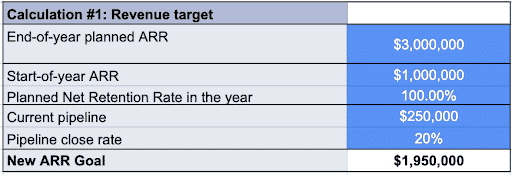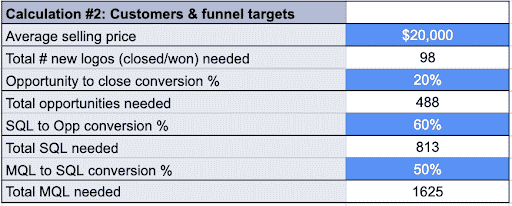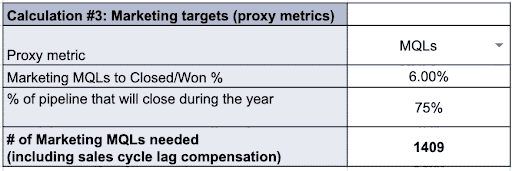Marketing drives revenue. You know it, and so do we.
But how do you align your goals with revenue?
A good place to start is to create a revenue model that sets achievable marketing goals based on revenue.
If you’re here just for the Revenue Model template click the button below
To help you, we created a template that is based on metadata.io’s demand model. When we interviewed Jason Widup, VP Marketing of metadata.io, he shared a template that Metadata created to help marketers track their goals. We use a similar model internally, and we knew we could push it further.
That’s why we decided to share our own updated model as an ungated template.
We added two additional steps to metadata.io’s model. The added steps relate to yearly and monthly budget calculations, which are critical to running a revenue marketing operation.
In this guide, we will review the steps you need to go through to use our revenue model template that acts as your north star throughout the year:
- Setting annual revenue targets
- Calculating the number of new customers as well as funnel targets
- Setting marketing targets (proxy metrics)
- Adding up the yearly costs and the needed budget
- Transforming the annual budget into monthly targets
Following these five steps, you’ll be able to track your marketing progress throughout the year, and you’ll know how close you are to reaching your revenue targets.
What is a revenue model?
A revenue model consists of easily measurable metrics that align with your sales funnel. The metrics can be tracked using a simple spreadsheet, such as the one we have provided above (you can also track these metrics using our platform, if you prefer efficiency *wink*).
Based on the revenue target, the model calculates how many customers, opportunities, SQLs, MQLs, and other metrics you need to achieve the company’s top-level revenue goals.
The revenue model spreadsheet has the advantage of limiting you to tracking only the most vital metrics you need to measure. It allows you to focus on creating awesome marketing activities, while still keeping a close eye on the relevant data.
Here’s a breakdown of each component of the revenue model. Feel free to use it for your B2B brand.
Step 1: Setting annual revenue targets

It’s common practice to set an annual revenue target, but I’ve seen many cases where the marketing team only looked at these numbers twice: at the start of the year, and before bonus season.
Using a revenue model, you’ll be able to visit the numbers at least once a month, and update your targets according to actual results.
The goal of this step is to calculate the New ARR Goal, meaning how much revenue should we generate after reducing current customer revenue and existing pipeline.
Here’s a breakdown of the metrics we’ll use:
End-of-year planned ARR: This is the total revenue the CEO expects to see by the end of the year.
This can be calculated in various ways, such as looking at last year’s performance, assessing investor expectations, calculating the runway needed to run the business, etc.
Start-of-year ARR and Net Retention Rate: Your business doesn’t restart every year. This metric accounts for the revenue you are generating from current customers, taking into account churned customers as well as expansions (calculated using Net Revenue Retention, or NRR).
Current Pipeline and Pipeline Close Rate: Here we take into consideration the existing pipeline your team generated last year, given the expected close rate percentage of pipeline that turns into closed/won. This will help you estimate how much revenue you can expect to generate from last year’s efforts.
New ARR Goal: This is the magic number.
The new ARR goal is what we aim at. It is the revenue we’ll bring in from the activities of the year, excluding the existing pipeline and revenue.
To get to this number, we used the following formula:
New ARR = Target ARR ($3M) – (Start of Year ARR ($1M) X Net Retention Rate (100%)) – (Existing Pipeline ($250K) X Expected Close Rate (20%))
If you are following our template, based on this calculation, our New ARR goal is $1.95M.
We will then split this number between sales and marketing (in the template we’ve added a 35%/65% split), giving us a final figure of how much revenue will be marketing’s responsibility.
Want to take the next step in Revenue Marketing?
Check out the InfiniGrow platform
Step 2: Calculating customer and funnel targets

Now that we have our New ARR goal, we can easily calculate the number of customers we need to close for the year, as well as other targets up the funnel.
We start with the average selling price.
Average Selling Price: Looking at our sales from the previous year, we can calculate the average selling price for our product.
Following our example, we’ll set our Average Selling Price at $20K.
Total new logos (closed/won) needed: If we divide the New ARR goal by our Average Selling Price, we will get the number of customers we need to close this year to reach our revenue goal.
This is an important number, since we will use it to trace the funnel back to the number of MQLs we need for the quarter.
When we divide the New ARR goal ($1.95M) by the Average Selling Price ($20K), we can see that the Yearly Customers amount to 98.
Opps/SQL/MQL goals
We now need to calculate our Opp/SQL/MQL goals for the quarter.
By looking at last year’s numbers, we can calculate the average conversion rates from one stage of the funnel to the other:
- Opp to close conversion rate – 20%
- SQL to Opp conversion rate – 60%
- MQL to SQL conversion rate – 50%
- Lead to MQL conversion rate – 50%
Given these numbers, we now know that to close 100 customers, we need:
- 500 opps (98 / 20%)
- 833 SQLs (488 / 60%)
- 1667 MQLs (813 / 50%)
- 3250 leads (1625 / 50%)
Step 3: Determining marketing targets

In our template, you’ll find a dropdown that lets you choose which proxy metric to set as your target. Switch the metric, and it will dynamically change the numbers throughout the entire spreadsheet.
Why even use a proxy metric like MQL?
While we are measuring our efforts in relation to revenue, we are also monitoring proxy metrics along the funnel (MQLs, SQLs, Opportunities…) that are correlated with revenue. We previously published an article about this subject here.
For the sake of keeping this article short, let’s use MQLs as our chosen proxy metric.
We mentioned the split between sales and marketing, but there’s another adjustment we need to make to the marketing MQL calculation.
Given that the sales cycle in B2B can be long, this means that some of the marketing activities that we will run this year will only affect next year.
In our example, the sales cycle is 60 days, and that’s why we estimated only 75% of the pipeline will close this year.
That’s why we then need to multiply the total number of MQL by marketing responsibility (65%), and then multiply it again by the percentage of pipeline that will close during the year (75%).
This amounts to 1409 MQLs, and that’s the number that marketing needs to deliver this calendar year.
You can use the same logic to calculate other metrics like SQLs or opportunities.
Step 4: Adding up the yearly costs and total budget

In this step, we go beyond targets and connect our budget planning with our revenue goals. This is a crucial step, since it connects the costs of our marketing with revenue, giving us a much clearer picture of the business validity of our marketing efforts.
This step aims to calculate the Total Needed Budget.
Total marketing budget, last year: We start with this number, and divide it by the number of MQLs marketing delivered last year. This will help us figure out what’s the Cost per MQL. (the same calculation can be done for SQLs and opportunities).
Total Needed Budget: Multiply the Cost per MQL by the number of marketing MQL from step 3, and we reach our total needed budget ($563,600).
We can choose to divide this number however way we choose, bearing in mind that by the end of the year, all the accumulated activities should produce our expected MQL target.
Step 5: Transforming the annual budget into monthly targets

Having a yearly budget that has been calculated from actual revenue goals is great, but you also need to maintain that budget every month.
There are countless models you can use to spread your budget across the year, taking into account:
- monthly improvements in efficiency and costs;
- seasonal spikes and dips in demand; and
- expected product releases or PR events.
In the second sheet of our spreadsheet, you’ll find a monthly target template, with two monthly target scenarios.
The first scenario is a simple linear model. The model spreads the budget according to the metric you chose in the first sheet (leads, MQLs, SQLs or opportunities). You enter the month-over-month growth rate of your chosen metric, and the yearly budget automatically spreads across months, according to the growth rate you set.
Here’s a trick to figure out which growth rate to set:
To calculate a growth rate that will be closest to your actual growth, look at last year’s December numbers. You should choose a growth rate that will not produce too steep a jump from December of last year to January of this year.
Let’s say you received 50 MQLs in December, and you enter 10% in the Month-over-month growth rate. January will now show 66 MQLs, but this might be an increase that is too steep to manage.
If you set the Month-over-month growth rate at 12%, this will reduce January’s target to 58, which is more manageable. Play around with the percentage, until you reach initial numbers and a growth rate that you can manage.
Custom monthly targets
Now that you have the linear growth budget, you can use it as a benchmark, and adjust the figures into the second monthly targets table.
Here is where you should factor in seasonality, meaning changes that can impact the surges and dips in MQLs at different points throughout the year.
Variations in budget growth may be connected to a recurring period or occasion, like Black Friday or the end of the year. These are yearly events that can be expected to boost or sink your numbers.
Scaling and diminishing returns
In our revenue model, we’ve used last year’s conversion rates to calculate the funnel stage transitions.
However, if you plan to scale your budget next year, you must take into account the diminishing returns, meaning the fact that when you scale your budget and efforts, you won’t get an equivalent scale-up in customers and other metrics.
You can either:
– assume a decline by looking at the reduced efficiency of previous scaling efforts;
– look at the current numbers and calculate a reasonable increase in costs; or
– use forecasting methods for more accurate results, which is beyond a marketer’s usual toolset.
Don’t set and forget: using the revenue model template
Having a detailed revenue model is like signing up for the gym. Yes, it’s an important first step, but the real work is just beginning.
Open your Google Calendar and set a weekly, monthly and quarterly appointment to review and examine your revenue model.
Do it now. I’ll wait.
Done?
Great!
Now you will no longer be overwhelmed or confused by the stack of assignments piling up on your desk.
In marketing, there’s always something to do: Creating sales enablement documents, running the next webinar, improving distribution, and repurposing content are all important tasks. Your real priority, however, is to closely monitor your Revenue Model and make decisions accordingly.
If you are curious about implementing revenue marketing beyond spreadsheets, feel free to check out our platform and book a demo with our team.



